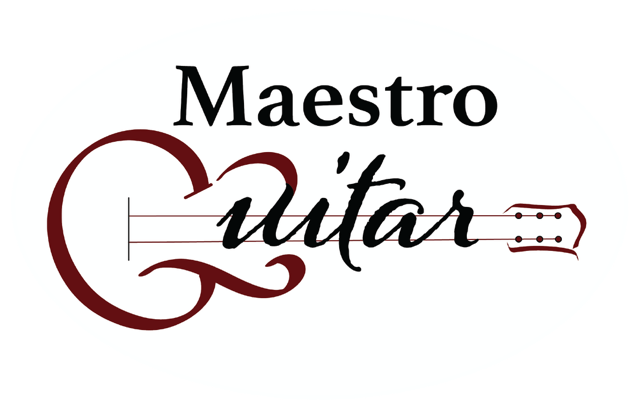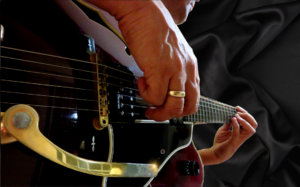“I bought a guitar, a cool amp, a whole library of books on how to play the guitar and I’m taking lessons at the local music store. Why can’t I play?”
This question is asked by 90% of all serious students, if not audibly, then in their minds.
Regardless of genre, music is music
It doesn’t matter if you want to play rock, country, classical, jazz or any other genre. Music is made up of the 12 notes of our chromatic scale coupled with organized sound and silence. Those of you who want to start as a beginner and become a rock and roll virtuoso soloist but get sucked into “how to play the guitar” from rock and roll video shredders are heading down the wrong road and in for heartache and disappointment.
What does it take to learn the guitar?
Learning an instrument and becoming proficient takes many years of practice, daily renewal, muscle memory development, and persistence – coupled with high-quality instruction. As with anything, all music books and all teachers are not alike.
There are teachers who learned to play some songs from friends, or how to play the introduction to Stairway to Heaven and think who you think can teach you. Run hard and run fast from these people. They will only lead you down the rabbit hole of emptiness and frustration by teaching bad habits giving incomplete or wrong information.
There are books on ‘how to play the guitar’ where after you have gone through the entire curriculum, you still can’t play a C scale. Yes, there’s good and bad in everything, and if you want to be a successful guitarist you have to find great instruction and then practice every day. Finding good instruction – therein lies the key.
There is a system to the shortest road to becoming an excellent guitar player. Even the shortest route still takes a long time. The majority of people do not have the patience required to ever get there, however, you can still enjoy your instrument by taking shortcuts. The problem with shortcuts is that they lead to bad habits, incomplete information, and missing pieces of your education.
Even if you just want to have a little fun with the instrument and don’t care about becoming a virtuoso, there are still fundamentals you must learn in order to make any kind of music.
For those of you who just want to learn to play a few chords around a campfire and sing songs, the road is much shorter.
With that being said, there are first steps necessary for having a simple level of proficiency on your instrument.
The fundamentals of music
The first step is to learn the basic elements of music. They are:
- Melody
- Harmony (chords are considered Harmony)
- How to properly count time
- Developing the physical ability to play chords and notes clean and accurately. Your goal here is to make the guitar sound the way you want it to sound.
For the average person mastering these skills, combined with proper instruction, should take about three years. From there, you could happily go on your way strumming chords and singing songs, enjoying your instrument for the rest of your life.
For those of you reading this who just want to strum chords and have fun with your instrument, the above is all that you need to focus on.
However, if you want to become a proficient musician, play gigs, work in a recording studio, write songs, write music, or work with other musicians, the road will be longer and of course the payoffs greater. Read on.
Your instrument is your voice
The ultimate goal of any musician is to be able to easily and proficiently play anything you hear in your head instantly, where your instrument becomes your voice, because in fact, it is.
Most will never achieve this because, frankly, it is not easy. But it can happen with proper instruction and lots of practice.
Can you sing Happy Birthday? Can you sing simple nursery rhymes? Can you play these easily on your instrument with your eyes closed?
If not, you have work in front of you. Your guitar has to become your musical voice.
So how do you get there?
Can you get there watching YouTube videos or by “learn how to play the guitar” books randomly picked off of a shelf at a local music store?
Most likely, no, unless you’re lucky enough to pick one of the few books out there that will lead you down the right Road coupled with daily focused practice.
However, here is an outline that you can follow to set you on the right Road.
Find a good teacher
When searching for a good teacher, ask them how they teach. Every quality instructor will follow the same basic rudiments and fundamentals of teaching their student how to read basic music, count time, and train the student’s ear to understand what they are hearing. If the teachers you are speaking with don’t have a system they follow to accomplish this, then keep looking.
Learn how to play your scales, arpeggios and chords forward and backward in all 12 keys in one position at a time.
Ear training
Ear training is so important. You will need to learn to hear a melody in your head and be able to play it on your instrument. Ear training will help you accomplish this. Ear training teaches you how to hear the intervals, or the distance between notes, the quality of harmonies and chords.
Reading music
Reading music is important because that is how musicians communicate. It is as important to being an educated musician as reading the English language is to being an educated American. It is how we communicate with each other.
Learning to read music has many benefits. It gives you lots of new musical ideas that will stay with you for the rest of your life. It teaches how to find sounds by seeing the distance between notes on the written page. It is this distance between notes – coupled with silence and sound – that create Melody and Harmony. You need to understand what you are hearing to be able to reproduce it. Reading music helps you write your ideas, songs, and other musical parts so you can communicate with other musicians.
Learning the entire guitar neck
The guitar is a polyphonic instrument, meaning you can play many notes at one time, and because of the design of the fretboard, the guitarist has the ability to play the same thing in four or five different spots. This can help you to be an efficient player, however, it also creates extra work because you don’t just learn one, for instance, C scale. You will need to learn that same scale in six different spots in order to master the neck.
After you understand everything above and have worked through all 12 keys in the first position, then move to the second position, then the third, then the fourth, relearning everything you learned to begin with. Work your way up the neck until you get to the top.
While you are doing this, it’s very important to practice playing simple songs to begin with, in all 12 keys in each position to learn the neck. You do not need to do this if you want to read music and, for example, play in an orchestra. Orchestra musicians need to become a master sight readers and develop the ability to articulate exactly what the writer had intended.
However, if you want to write music or go on to be an improvisationalist, you really need to ensure that your guitar becomes your voice. You have to know it that well.
To accomplish this, practice playing as many songs as you can in different keys and the different positions. don’t rush through this. Take it one song at a time and learn them well before moving on to the second song. This is a lifelong process. Practice hearing a melody in your head and then finding it on your instrument. After you get it, you got and then you don’t have to keep doing it…if that makes sense.
The above is a lot of work. It is a lifelong process, but for those who love music, it will be like a picnic in the park and you will love to do it every day.
If you’re one of these people, give us a call or send us an email! We can lead you down the right road, teach you everything you need to know to become the guitarist and musician that you want to be – the right way. After all, the shortest shortcut is to do it the right way the first time.

